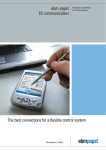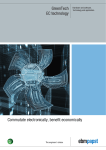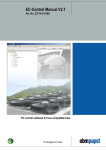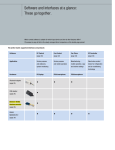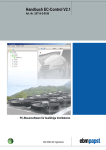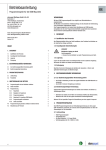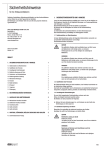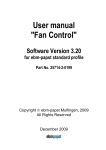Download au
Transcript
Operating instructions for built-in fans with three-phase powered motors, sizes 112 and 150 The device type, date of manufacture (calendar week/year) and the conformity sign are located on the type plate on the fan. For questions about the fan or the delivery of spare parts, please provide the entire content of the type plate. ebm-papst Mulfingen GmbH & Co. KG Bachmühle 2 D-74673 Mulfingen, Germany Phone.: +49-7938-81-0 Fax: +49-7938-81-110 [email protected] www.ebmpapst.com 1. SAFETY REGULATIONS AND NOTES Please read these operating instructions carefully before starting to work with the device. Observe the following warnings to prevent malfunctions or danger to persons. Ensure that the operating instructions are always readily available at the device. If the device is sold or transferred, the operating instructions must accompany it. These operating instructions may be duplicated and forwarded for information about potential dangers and their prevention. Warning notices These operating instructions use the following notices to indicate potentially hazardous situations and important safety regulations: Danger! Indicates a potentially hazardous situation, Exercise extreme caution while working. Revised: 22 November 2007 Version 1.0 Warning! Indicates a potentially hazardous situation, which, if not avoided, can result in injuries. Exercise extreme caution while working. Caution! Indicates a potentially hazardous situation, which, if not avoided, can result in minor injuries or property damage. CONTENTS 1. SAFETY REGULATIONS AND NOTES 1 1.1 Electrical voltage and current 1.2 Safety and protective functions 1.3 Electromagnetic radiation 1.4 Mechanical movement 1.5 Hot surface 1.6 Emission 1.7 Transport 1.8 Storage 1.9 Cleaning 1.10 Disposal 2 2 2 2 2 2 2 2 2 2 2. PROPER USE 3 3. TECHNICAL DATA 3 4. CONNECTION AND START-UP 3 4.1 4.2 4.3 4.4 3 3 5 6 Attention! Indicates a potentially harmful situation, which, if not avoided, can result in property damage. Staff qualification Only specialised electrical personnel may install the device, perform the test run and work on electrical system. Only trained and authorised specialist personnel are permitted to transport, unpack, assemble, operate or maintain the device, or to use it in any other manner. Basic safety rules Observe the following when working with the unit: Warning! Connecting the mechanical system Connecting the electrical system Checking the connections Switching on the device 5. INTEGRATED PROTECTIVE FUNCTIONS 6 6. MAINTENANCE, MALFUNCTIONS, POSSIBLE CAUSES AND REMEDIES 6 Rotating fan Long hair, dangling items of clothing and jewellery could become entangled and pulled into the device. You could be injured. ➜ Do not wear any loose clothing or jewellery while working on moving parts. Protect long hair with a hood. – Do not make any modifications, additions or conversions to the device without the approval of ebm-papst. 1 1.1 Electrical voltage and current 1.6 Emission Check the electrical equipment of the device at regular intervals. Remove loose connections and defective cables immediately. Warning! Depending on the installation and operating conditions, a sound pressure level greater than 70 dB(A) can arise. Danger of noise-induced hearing loss ➜ Take appropriate technical safety measures. Safeguard the operating personnel with appropriate protection measures, e.g. ear protectors. Danger! Electrical load (> 50 μC) between mains wire and protective earth connection when switching multiple devices in parallel Electric shock, risk of injury ➜ Ensure that sufficient protection against accidental contact is provided. Before working on the electrical connection, the L1, L2, L3 and PE connections to the mains supply must be shorted. 1.7 Transport Caution! Caution! Transport of fan Cutting and crushing hazard ➜ Wear safety shoes and cut-resistant safety gloves. Transport the fan in its original packaging only. The vibration values listed in the technical data must not be exceeded during the entire transport. Secure the fan so that it does not slip, for example using a lashing strap. In the event of fault, electric voltage is present at the rotor and impeller The rotor and impeller are base insulated. ➜ Do not touch the rotor and impeller when they are installed. 1.2 Safety and protective functions Danger! 1.8 Storage Missing safety device and non-functioning protective features Risk of fatal injury ➜ Shut down the device immediately if you detect a missing or ineffective protective feature. The device is an installation item that has no function on its own. As the operator, you are responsible for ensuring that the device is adequately secured. Store the device in a dry place, where it is protected in a clean environment. Keep to the specified storage temperatures, please refer to Chapter 3, Technical data. If the device remains out of use for some time, we recommend switching the device on once a month for about 15 minutes to move the bearings. 1.9 Cleaning 1.3 Electromagnetic radiation Interference from electromagnetic radiation possible, e.g. in conjunction with open and closed-loop control devices. If unacceptable emission intensities occur when the fan is installed, suitable shielding measures must be taken before the device is commissioned. Attention! Damage to the device during cleaning. Malfunction possible ➜ Do not clean the device using a water jet or high-pressure washer. Do not use any cleaners containing acids, bases or solvents. 1.4 Mechanical movement Danger! 1.10 Disposal Rotating fan Body parts that come into contact with the fan while it is rotating can be injured. ➜ Secure the fan to prevent contact. Before working on the installation/machine, wait until all parts have come to a standstill. When disposing of the device, please comply with all relevant requirements and regulation applicable in your country. Warning! Ejected parts in the exhaust zone Danger of injury In the event of a fault, balancing weights or broken fan blades may be ejected. ➜ Take appropriate safety measures. Do not stay in the exhaust zone. Caution! Self-starting fan Danger of injury If control voltage is applied or a speed setpoint is stored, the motor automatically restarts, for example after a power failure. ➜ Do not stay in the danger area of the fan. When working on the fan, switch off the mains supply voltage at all poles and secure it from being switched on again! 1.5 Hot surface Caution! High temperature at the motor housing Danger of burn injuries ➜ Ensure that sufficient protection against accidental contact is provided. 2 2. PROPER USE 4. CONNECTION AND START-UP The device is designed exclusively as built-in fan for moving air according to the technical data. Any other or secondary use is deemed improper use and a misuse of the device. Installations necessary on the part of the commissioning party must meet the mechanical, thermal and service life-related stresses that can occur. – Operating the device with all protective features. – Observing the operating instructions. – Use of the device in accordance with the permissible ambient temperature, see Chapter 3 "Technical data" Improper use In particular, the following uses of the fan are prohibited and can lead to dangerous situations: – – – – Install the device according to your application. Use the device according to its moisture class. Caution! Proper use also includes: – – – – – – – – – 4.1 Connecting the mechanical system Moving air that contains abrasive particles. Moving highly corrosive air. Moving air that contains dust pollution, e.g. suctioning off saw shavings. Using the fan to move flammable gases/particles. Operating the fan in the vicinity of flammable materials or components. Operating the fan in an explosive atmosphere. Using the fan as a safety component or for taking on safety-related functions. Operation in medical equipment with a life-sustaining or lifesaving function. Operation in non-stationary installations such as railroad vehicles, aircraft and spacecraft. Operation with completely or partially disassembled or modified protective features. Operation in IT networks. Operation with external vibrations that exceed the permissible vibration load. In addition, all application options that are not listed under proper use. Cutting and crushing hazard when removing the fan from the packaging ➜ Carefully lift the device out of the packing at using inside area of the blades (axial fan) or the impeller (radial fan). Be certain to avoid any shock. Wear safety shoes and cut-resistant safety gloves. Two people should lift the device out of its packaging if it is heavier than 10 kg. Warning! Hot motor housing Danger of fire ➜ Ensure that no combustible or flammable materials are located in the vicinity of the fan. Attention! Incorrect mounting position, condensation occurs The condensation water cannot run off. ➜ Install the device only in an installation position with the shaft horizontal or the rotor at the bottom. This allows the condensation water to run off. Installations necessary on the part of the commissioning party must meet the mechanical, thermal and service life-related stresses that can occur. They should also be able to stand up to higher loads, e.g. those caused by a failure of a thermal overload protector. If you have specific questions, contact ebm-papst for support. 3. TECHNICAL DATA In ambient conditions where there is no condensation, the device may be installed in any installation position. Additional device-specific data are available upon request from ebm-papst. 4.2 Connecting the electrical system Mounting data The connection to the electrical system is made after the connection to the mechanical system. The following must be observed: – Tightening torque of the screwed cable gland: 3.0 Nm – Tightening torque of mounting screws of terminal box cover: 2.5 Nm – Strength of mounting screws: 10.9 – Before connecting the device, ensure that the mains supply voltage matches the fan voltage. – Only use cables that are configured for current according to the nameplate. Danger! Secure mounting screws against accidentally coming loose (e.g. self-locking screws). Leakage current Leakage current ≤ 3.5 mA Attention! Ambient conditions Permitted ambient temperature for motor Incorrect insulation Risk of fatal injury from electric shock ➜ Use only cables that meet the specified installation requirements for voltage, current, insulation material, load etc. Transport & storage Operation -40 °C to +80 °C -25 °C to +60 °C Resistance to vibrations 1 g (acc. to IEC 60068-2-6) Device malfunctions are possible ➜ Do not route the control lines of the device directly parallel to the power supply line. Ensure a sufficiently large clearance. Recommendation: clearance > 10 cm (separate cable routing). 0.5 g (acc. to IEC 60068-2-6) 3 Stripping connecting cables Strip the cable just enough so that the screwed cable gland is tight and the terminals are relieved of strain (for tightening torques, refer to Chapter 3 "Technical data"). 50 6 Control lines Figure 6: Connecting the wires to terminals L1, L2, L3 6 Protective earth 6 60 Figure 1: Recommended stripping lengths in mm (inside the terminal box) Connecting cables with terminals Caution! Electrical voltage The fan is a built-in component and features no electrically isolating switch. ➜ Only connect the fan to circuits that can be switched off with an all-pole separating switch. When working on the fan, you must switch off the installation/machine in which the fan is installed and secure it from being switched on again. Dangerous external voltages may be present at the terminals and connections, even when the device is switched off. – Open the terminal box. – Open the screwed cable gland. Size 112 motors Size 150 motors All screwed cable gland are supplied with a sealing cap and insert for cables with Ø 4 - 10 mm, see Fig. 2. All screwed cable gland are supplied with a sealing cap and insert for cables with Ø 5 - 9 mm, see Fig. 2. No water may penetrate along the cable in the direction of the cable gland. Mounting position of fan: shaft vertical, rotor at bottom Ensure that the cable is routed in the form of a loop ("water trap" see Figure 7). – Remove the cap, see image 3. Remove the cap only at those places where cables are introduced. Size 112 motors Size 150 motors For two cables Ø 5 mm, see Figure 4, you must equip the screwed cable glands with the seal inserts provided in the terminal box. With two cables Ø 4 - 6 mm, see Fig. 4, or with one cable with Ø 6 - 12 mm, you must fit the sealing inserts provided in the terminal box to the screwed cable gland. Figure 7: Fan installed lying flat (shaft vertical, rotor on bottom), cable routed as "water trap" Figure 2. Screwed cable gland with cap Figure 3. Cap removed Figure 4. Seal insert, equipped for two cables – Guide the cable through the screwed cable gland. – Connect "PE" (protective earth) conductor. – Connect the remaining leads to the respective terminals. To do so, use a 3.5 mm screwdriver, see Figure 6. During the connection work, ensure that no wires splice off. 4 Figure 5. Seal inserts fitted with one cable are prohibited! Mounting position: shaft horizontal When routing the cables, make sure that the screwed cable gland is located at the bottom, see Fig. 8. The cables must always be routed downwards. Terminal assignment 3~ /PE Circuit breaker Wire cross-section VDE UL VDE mm² AWG 16 A 15 A C16 A 1,5 16 380 - 480 VAC 20 A 20 A C20 A 2,5 14 3~ /PE — 15 A — 1,5 16 200 - 240 VAC — 20 A — 2,5 14 L1 L2 L3 1 PE NC 2 Function Protective earth conductor KL1 1 L3 Mains; L3 2 L2 Mains; L2 3 L1 Mains; L1 1 NC Relay status; NC contact with error Load max. 250 VAC / 2 A at cosϕ = 1 2 COM Relay status; COMMON Load max. 250 VAC / 2 A at cosϕ = 1 3 NO Relay status; NO contact with error Load max. 250 VAC / 2 A at cosϕ = 1 1 OUT 0 - 10 V Master output for control of several slave fans; max. 10 mA 2 GND GND 3 0 - 10 V / PWM Analogue input; Input resistance 100 kΩ PWM frequency 1 kHz 4 10 V 10 V + 15 % supply for ext. potentiometer; max. 10 mA; short-circuitproof 5 20 V 6 4 - 20 mA 20 V +/- 20 % supply for ext. sensor; max. 50 mA; short-circuitproof Analogue input; 4 - 20 mA; Load 100 Ω; Voltage drop 2 V at 20 mA 7 0 - 10 V / PWM Analogue input; Input resistance 100 kΩ PWM frequency 1 kHz 8 GND GND 9 RS B RS485 interface for ebmBUS; RS B connection 10 RS A RS485 interface for ebmBUS; RS A connection 11 RS B RS485 interface for ebmBUS; RS B connection 12 RS A RS485 interface for ebmBUS; RS A connection Power supply connection, fuse protection Safety fuse 3 PE Danger! Ratedvoltage 1 Name KL3 Make sure that the terminal box is correctly closed and sealed after completing the work and that all screws are properly tightened. 2 --- 4.3 Checking the connections – Check the correct fit of the connecting cables. – Fasten the screwed cable gland again. – Ensure that the cable gland is securely tightened. Any unused screw connections must always be fitted with a cap and securely tightened. – Tighten the cable gland enough to ensure that water cannot ingress. Refer to Chapter 3, "Mounting data" section, for the maximum tightening torque – Fasten the terminal box again. Refer to Chapter 3, "Mounting data" section, for the maximum tightening torque 3 PIN Figure 8: Cable routing for upright built-in fans (shaft horizontal) Ensure power is off. Secure it from being switched on again. 1 PE KL2 Electric voltage on the device Electric shock ➜ Always install an earth wire. Check the protective earth. 2 PE NO 3 KL1 COM 4 OUT 5 GND 6 0-10 V PWM 7 +20 V 8 KL2 +10 V 9 4-20mA GND 10 0-10 V PWM RS A 11 RS B RS A 12 RS B KL3 KL3 is a current circuit separate from the power system. Residual current operated device Only all-current-sensitive RCD protective devices (type B) are permissible. Like frequency inverters, RCD protective devices cannot provide personal safety while operating the device. 5 Factory settings The factory settings/modes of operation have the following default values upon delivery: Mode of operation: PWM control Set value input: Analogue input Store set value in EEPROM: ✓ (ticked) Min. PWM: 0% Max. PWM: 100 % Direction of action of controller: positive (heat) Fan address: 1 Group address: 1 If you have not obtained your device directly from ebm-papst, we recommend that you obtain the default settings from your supplier. Your supplier may have modified the settings. 6. MAINTENANCE, MALFUNCTIONS, POSSIBLE CAUSES AND REMEDIES Do not perform any repairs on your device. Return the fan to ebm-papst for repair or exchange. Danger! Electric voltage on the motor Electric shock in case of contact ➜ Wait five minutes after disconnecting the voltage at all poles before opening the device. Exterior installation: if the fan remains out of use for some time, we recommend switching the fan on for at least 2 hours to allow any condensation ingress to evaporate. 4.4 Switching on the device Malfunction/error Inspect the device for visible external damage and the proper function of the protective features before switching it on. Motor does not turn Mechanical blockage – Mains supply voltage faulty Possible cause – Apply the voltage to the device. – Switch on the device via the control voltage. If you switch off the device, for example for service or due to malfunctions, note the following: The control voltage circuit is not electrically isolated. Only connect the fan to circuits that can be switched off with an all-pole separating switch. Overtemperature of electronics Overtemperature of motor Possible remedy – Switch it off and remove mechanical blockage – Check mains supply voltage, restore power supply – Apply control voltage – Ambient tempera- – Reset by switching off the ture too high mains supply voltage for at – Insufficient cooling least 20 s after motor stand– Unacceptable opestill rating point – Reset via ebmBUS Incorrect rotor posi- – Failure of electrotion detection nics 5. INTEGRATED PROTECTIVE FUNCTIONS Error Description / Function of safety feature Overtemperature of electronics If one of these errors occurs, the motor switches off electronically, the status relay drops out and the error is reported via ebmBUS. Overtemperature of motor No automatic restart occurs. Rotor position detection error Blocked rotor ➜ Reset by switching off the mains supply voltage for at least 20 s after motor standstill or by reset via ebmBUS. If the rotor is blocked, the motor switches off electronically, the status relay drops out and the error is displayed via ebmBUS. ➜ After the block is removed, the motor automatically restarts. Line under-voltage If the mains input voltage drops below the voltage 3~ 290 VAC (nominal voltage 380 - 480 V) or 3~ 145 VAC (nominal voltage 200 - 240 V) for at least 5 s, the motor is shut off electronically, the status relay drops off and the fault is displayed via ebmBUS. ➜ If the supply voltage returns to permitted values, the motor automatically restarts. Phase failure If a phase of the supply voltage fails for at least 5 s, the motor switches off electronically, the status relay drops out and the error is displayed via ebmBUS. ➜ If all 3 phases are correctly supplied again, the motor automatically restarts after approx. 10 - 40 s. 6 If you have any other problems, contact ebm-papst. Safety test What has to be tested? Protective covering How to test? Visual inspection Frequency at least every 6 months Fan for damage Visual inspection at least every 6 months Mounting of fan Visual inspection at least every 6 months Mounting of connecting cables Visual inspection at least every 6 months Mounting of protective earth connection Visual inspection at least every 6 months Insulation of the cables Visual inspection at least every 6 months








